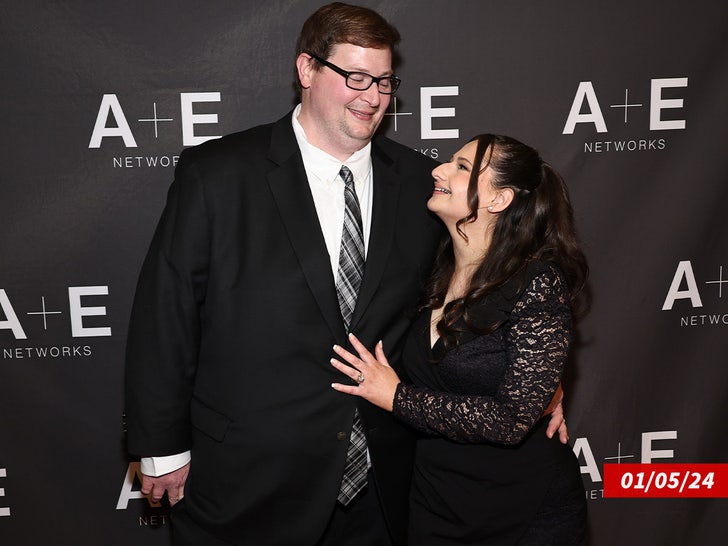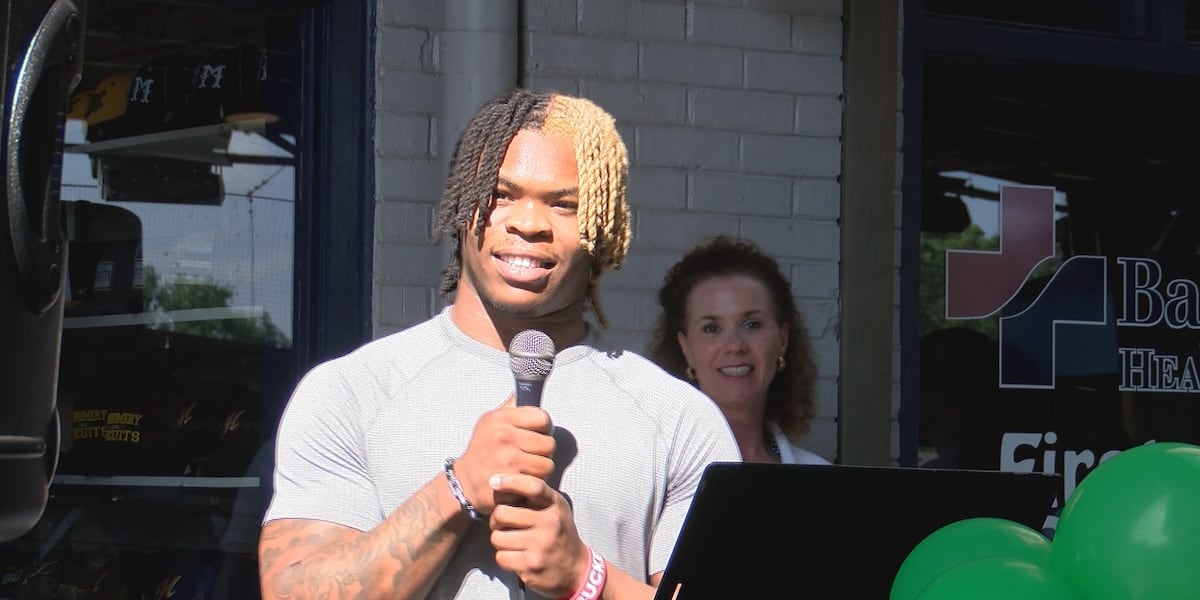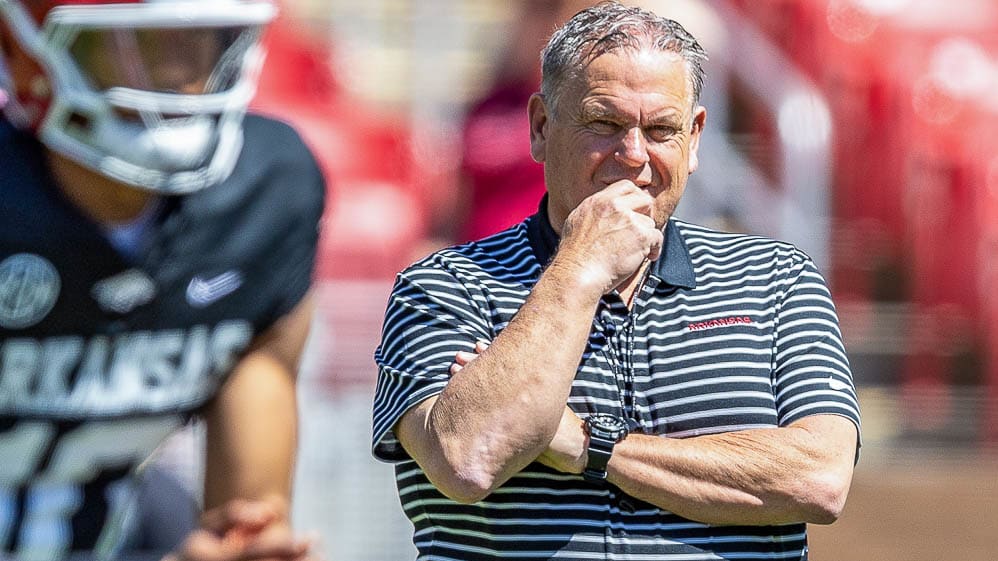Lifestyle
Netflix's 'Baby Reindeer': A dark, haunting story bungles its depiction of queerness

Richard Gadd as Donny in Baby Reindeer. The new Netflix series is based on Gadd’s autobiographical one-man show.
Netflix
hide caption
toggle caption
Netflix

Richard Gadd as Donny in Baby Reindeer. The new Netflix series is based on Gadd’s autobiographical one-man show.
Netflix
Note: You can’t really talk about this series without discussing a major revelation that occurs in episode four of its seven-episode season. So be warned: Spoilers ahead.
There’s a reason that the first scene in the first episode of Baby Reindeer, now streaming on Netflix, plays like it’s a classic setup to a joke: Woman walks into a bar.
Creator and star Richard Gadd is setting our expectations exactly where he wants them set; he needs us to think that the story he’ll tell us over the next seven episodes will conform to the narrative contours of dark comedy.
He’s already tipped us off that the comedy in question will be dark indeed, via a framing device that opens the show: We see his character Donny Dunn filing a police report that he’s being stalked by a woman named Martha (Jessica Gunning).
Cut to six months earlier: Martha enters the pub where Donny tends bar. Everything that follows is meant to place us inside Donny’s head. As he tells us about her, we can’t help but see her as he does: A sad, fat, pitiable middle-aged woman who’s clearly lying about her life. She’s not the high-powered lawyer she says she is – if she were, surely she could afford to buy a drink. And why would she spend all those potentially billable hours bellied up at Donny’s bar whenever he’s working a shift? And why would she proceed to send him thousands of unhinged text messages and stalk him, his girlfriend, and his family?
Right, we think. We know what we’re in for: Baby Reindeer is the story of one hapless young man getting cruelly stalked by a mentally ill woman, who, it turns out, has a history, and a criminal record, for doing so.
Moreover, it’s a true story. True-ish, anyway, as Baby Reindeer is based on Gadd’s autobiographical one-man show.
But Gadd soon complicates our understanding of events. It turns out Donny is a struggling would-be comedian; we watch a series of his cringeworthy sets before sparse, stone-faced audiences. He seems depressed and friendless – his work colleagues at the bar are hostile louts; he’s living with his ex-girlfriend’s mother on the outskirts of London.
Plus there’s the nagging fact that while Donny may not actively encourage Martha’s fawning attention, he is awfully passive about shutting down her determination that they could get together, even as she grows more insistent, and more threatening.
Also, as the cop asks him at the start of the first episode. Why did he let it all go on for six months before filing a formal complaint?

Jessica Gunning as Martha.
Netflix
hide caption
toggle caption
Netflix

Jessica Gunning as Martha.
Netflix
The rug-pull
The answer to that question is what Baby Reindeer is truly about. It’s where the conventional and familiar trappings of dark comedy and psychological thriller fall away to reveal the show’s true, beating heart: Sexual abuse, and its lingering aftermath.
It isn’t until episode four that we learn that five years before Martha entered his life, Donny met a successful television writer named Darrien (Tom Goodman-Hill) who gave him career advice, promised to set him up with opportunities, and supplied him with drugs. During those sessions, while Donny was helpless to stop him, Darrien would sexually abuse him.
This, the series proceeds to argue – far too tidily – is the answer to everything. It’s why Donny became the depressed, self-loathing man we’ve come to know. It’s why his comedy career stalled. It’s why he’s since chosen to degrade himself by having meaningless sex with both men and women, doing more drugs, and by developing an interest in “extreme” pornography.
It’s also, of course – or so the show would have us believe – why he was so disarmed and flattered by the attention Martha gave him, which seems (compared to the drug-filled sexual cesspits he once frequented) pure and wholesome and, not for nothing, reassuringly straight. At one point Donny guiltily admits to us that, at his very lowest point, he even started to find Martha – imagine that! a fat woman! – sexually arousing.
It’s this aspect of Baby Reindeer – Gadd/Donny’s ultimate willingness to confront his abuse and explore its aftereffects – which has earned the show its most fulsome praise from critics and audiences. But in practice, the series repeatedly and clumsily conflates the horror of abuse with the simple fact of queer sexuality. Purely for dramatic purposes, Baby Reindeer implies that Donny’s sexuality conforms to the laws of cause (the abuse) and effect (queerness). Worse, it does so in a way that seems specifically designed to reassure those audiences who believe queerness is something that happens to people, something that can be triggered from the outside.
Catching queerness like a cold
Let me be clear: Baby Reindeer is not making any kind of broad sexual/political case that same-sex abuse leads its victims to experience same-sex desire. Neither is it saying that all putatively straight men who get sexually abused by other men will henceforth be attracted to trans women.
But it does want us to believe – in fact it entirely depends upon us believing – that Donny, for one, experienced same-sex desire only after his abuse – desire it goes out of its way to depict as filthy and degrading. It does, too, want us to believe that Donny failed to make any romantic connections with women or men after his abuse – until he met Teri (Nava Mau) on a trans dating site.
Gadd himself identifies as bisexual, which makes it all the more puzzling and frustrating that, again and again, the series takes absurd pains to present Donny as someone who is not at all like the kinds of queer folk who (shudder!) willingly have sex with each other and (shock horror!) use recreational drugs and (gasp!) watch porn.
Rest assured, straight audiences: Donny’s queer sexuality was something forced upon him – a fact that his stoic father (Mark Lewis Jones) understands and underscores because, as he tearfully explains to his son, “I grew up in the Catholic Church.”
It’s a jaw-dropping scene, but not for the reason it wants to be. It’s meant as a moment of startling honesty and searing empathy between father and son.
It plays like a tasteless, homophobic joke.
Sticking the dismount
For all its queasy discomfort with, and prissy diffidence about queer sexuality, there is one thing Baby Reindeer gets absolutely, hauntingly right: Its ending.
As the series concludes, Martha has been jailed for stalking Donny. In a thinner, less resonant series, our hero would take this as an unalloyed victory, as vindication. But smartly, Gadd shows us a Donny who has acknowledged his abuse but has only begun to effectively deal with it.
Donny, instead, wallows. He walks the streets, playing Martha’s tender/terrifying voicemails in his headphones. He sets out to confront his abuser, only to cave and accept a job working for him. He shambles through his life alone, until he enters a pub (Man walks into a bar) and realizes he can’t pay for his drink. The handsome bartender comps him out of pity, just as Donny did to Martha in the first episode. The end.
… OK, that pity-drink callback at the very end is a bit on-the-nose, but the series’ refusal to afford Donny a clear, uncomplicated, once-and-for-all victory is a smart one. Had the series ended with a sense of triumph and finality, it would have been dramatically satisfying but emotionally dishonest. Human psychology is more complex than that, and the damage done by abuse more insidious.
When we leave him, Donny is still trapped by his past, because he hasn’t yet done the work he needs to do. He still believes he deserves to be trapped, defined, by what happened to him.
But the series plants the seeds for the change that we know is coming: When he’s alone in that room of his, he’s turning his experience into the one-man show that will become Baby Reindeer. It’s that process of transmutation and creation that will ultimately allow him to process his abuse and turn it into something that engages with the wider world, and grant him the ability, finally, to heal.
Maybe, in the process, he will manage to move past finding other queer folk and fat people disgusting. Baby Reindeer suggests that Richard Gadd hasn’t quite managed to do that, yet.
But I’m holding out hope for Donny.

Lifestyle
In 'The Fall Guy,' stunts finally get the spotlight

Ryan Gosling plays stunt man Colt Seavers in the new movie The Fall Guy, a new take on the 1980s TV show.
Eric Laciste/Universal Pictures
hide caption
toggle caption
Eric Laciste/Universal Pictures

Ryan Gosling plays stunt man Colt Seavers in the new movie The Fall Guy, a new take on the 1980s TV show.
Eric Laciste/Universal Pictures
At the Hollywood premiere of the new movie The Fall Guy, motorcyclists popped wheelies along the red carpet, one stuntman took a dive off a 45-foot crane outside the Dolby Theater, and Ryan Gosling’s stunt doubles were ripped backwards through a movie poster. Three performers smashed through a window for a lively staged fight scene.
The movie’s storyline and its massive global marketing campaign are all about giving credit to Hollywood’s behind-the-scenes action stars. In every appearance, Gosling lavishes praise, noting he’s had a stunt double since his 1990’s TV show Young Hercules.
“I kind of had a stunt double my whole life,” he explained at the premiere at South By Southwest. “It’s always been this strange dynamic where they come and do all the cool stuff and then they go and hide, and you pretend that you did it. And it’s not cool…it’s about time that we recognize that they’ve been making actors into movie stars for a century.”

A stunt performer at the Los Angeles premiere of The Fall Guy. Outside the Dolby Theatre, another stunt artist jumped from atop a 45-foot crane, while others showed off a staged fight scene.
Valerie Macon/AFP via Getty Images
hide caption
toggle caption
Valerie Macon/AFP via Getty Images

A stunt performer at the Los Angeles premiere of The Fall Guy. Outside the Dolby Theatre, another stunt artist jumped from atop a 45-foot crane, while others showed off a staged fight scene.
Valerie Macon/AFP via Getty Images
The Fall Guy is an action movie within an action movie: In the film, Ryan Gosling plays Colt Seavers, a stunt man trying to win back his film director ex, played by Emily Blunt. When the movie star for whom he doubles goes missing, Seavers is sent on a mission to find him.
Gosling did a few of his own stunts for the movie, including falling backwards 12 stories from a building. He did a fight scene inside a garbage bin spinning through the streets, and he surfed on a metal plate dragged by a truck on the Sydney Harbour bridge.
But Gosling’s stunt doubles did even more daring tricks.

“I got pulled back maybe 20 feet into a massive rock while on fire,” recalls Ben Jenkin, a parkour specialist who stood in for Gosling’s character as he was set on fire over and over. “I did the ‘fire burn’ eight times in one day. That was actually one of the ones that hurt the least.”
Throughout production, Jenkin took more than a few punches.
“The car hit wasn’t fun,” he told NPR. “I mean, it was fun to do, but the pain! It definitely hurt my leg a little bit when I smashed through the front windshield and landed on the road. That was a thumper. You watch the movie and you see the stunts and you’re like, ‘Oh my god, that’s crazy. That must have hurt.’ But you don’t see the prep that went into it.”

The new movie The Fall Guy is an update of the 1980’s action TV show of the same name starring Lee Majors, shown here in 1981. Majors makes a cameo in the new movie.
Walt Disney Television Photo Archives/Getty Images
hide caption
toggle caption
Walt Disney Television Photo Archives/Getty Images

The new movie The Fall Guy is an update of the 1980’s action TV show of the same name starring Lee Majors, shown here in 1981. Majors makes a cameo in the new movie.
Walt Disney Television Photo Archives/Getty Images
Pulling back the curtain on stunts
The movie was directed by former stuntman David Leitch, who spent 20 years doubling for A-list actors like Brad Pitt and Matt Damon before making such action films as Atomic Blonde, Bullet Train, John Wick and a Fast and Furious spinoff.
For The Fall Guy, Leitch says he wanted all the stunts to be old school and practical — using real people, not AI or CGI.
“We did high falls out of helicopters. We lit people on fire multiple times,” Leitch told NPR. “Cars flipping, crashing, fight scenes, bottles broken. A lot of stunts. We really put everything into it. Honestly, we knew we had to make sure we did right by the stunt community.”
Posing as Gosling’s character in the movie, aerialist Troy Brown took a backwards 150-foot fall out of a helicopter to land onto the same airbag his legendary stuntman father Bob Brown once landed on for a movie.
Stunt driver Logan Holladay jumped a truck over a 225 foot-wide canyon. And for another scene, he broke a Guinness World Record. Driving 80 miles per hour on a wet, sandy Australian beach, Holladay maneuvered a modified Jeep Grand Cherokee. A blast from an air cannon under the SUV propelled it to roll over itself eight and a half times. (The previous record for cannon rolls in a car was seven, held by Adam Kirley for the 2006 James Bond film Casino Royale.)

Ryan Gosling, Aaron Taylor-Johnson, Ben Jenkin, Logan Holladay, and Justin Eaton, along with director David Leitch on set.
Eric Laciste/Universal Pictures
hide caption
toggle caption
Eric Laciste/Universal Pictures

Ryan Gosling, Aaron Taylor-Johnson, Ben Jenkin, Logan Holladay, and Justin Eaton, along with director David Leitch on set.
Eric Laciste/Universal Pictures
“Logan gets out of the car and gives us the thumbs up, and we know he’s okay,” recalls the movie’s stunt designer, Chris O’Hara. He and his team had carefully calculated the density of the sand and the speed.
“It’s definitely a science,” he told NPR. “It’s not just, you know, go crash a car; We’re really doing our due diligence to make it the perception of danger while eliminating all the risks so that in the end, we can make something super exciting.”
David Leitch says all of the stunts in the movie are also there to serve the story. “There’s a lot of math, there’s a lot of physics, there’s a lot of physicality and performance,” he says. “But there’s also this artistic design and creativity. Like, how is this sequence going to move the character forward? How is this sequence going to be more fun? How are we going to make them laugh? How are we going to make them be scared?”

Emily Blunt plays Judy Moreno in The Fall Guy.
Eric Laciste/Universal Pictures
hide caption
toggle caption
Eric Laciste/Universal Pictures

Emily Blunt plays Judy Moreno in The Fall Guy.
Eric Laciste/Universal Pictures
Campaigning for an Oscars category
Unlike costume designers, hair and makeup designers, and soon, casting directors, the Academy Awards have never had a category for stunts. But The Fall Guy stars Gosling and Blunt made a pitch for one at this year’s Oscars ceremony.
“To the stunt performers and the stunt coordinators who help make movies magic,” Gosling said onstage, “we salute you.”
That support is appreciated by stunt performers like Michelle Lee, who doubles for Rosario Dawson in the Star Wars spinoff series Ahsoka. She hopes this effort helps people understand discipline and sacrifices stunt performers make to entertain audiences. “Sometimes, you pad up and you’re like, ‘Oh, this one’s going to hurt,’ but this is what I’m here for and I’ve practiced,” she says. “You know, pain is temporary, film is forever. You have that cool shot forever.”
Mike Chat and Neraida Bega train Hollywood stunt performers at a center run by 87 North, the production company run by The Fall Guy director David Leitch and his producer wife Kelly McCormick. They say that for years, stunt performers have campaigned for the Academy to honor their work.
“People have petitioned, they’ve gone out and picketed,” says Chat. But that didn’t work, says Bega.
“The fear was that people were going to make the stunts more dangerous and bigger and bigger for them to win. But that is not the goal,” Bega says. “There is so much discipline, they work so hard and they have to be always ready.”
Chat has been in the business for more than 20 years. He and others hope The Fall Guy may finally convince the Academy to award an Oscar for best stunts.
“They have taken the initiative to say, ‘OK, we’re going to educate you, we’re going to earn it, we’re gonna prove it and show you why it’s deserved.’”
And for that effort, he says the stunt community around the world is giving The Fall Guy a big thumbs up.
Lifestyle
Gypsy Rose Gave Wedding Ring Back to Estranged Husband, Family Heirloom

Gypsy Rose Blanchard has already given back her wedding ring to estranged husband Ryan Anderson … because the piece of jewelry meant quite a bit to him, TMZ has learned.
Sources close to Gypsy Rose tell TMZ … she felt it was the right thing to give back the ring — as it was a family heirloom given to Ryan by his mom. We’re told Gypsy Rose left the ring with Ryan when she made the decision to end her marriage … along with an apology note next to their bed on March 22.

The note read … “I’m sorry, you and I deserve happiness.”
BTW … legally speaking, she didn’t have to return the ring. Once they tied the knot, it was hers unconditionally.
As Ryan explained on ‘Life After Lock Up’ … he snuck the jewelry into the prison where Gypsy Rose was doing time for her role in the murder of her mom, Dee Dee Blanchard.

Remember, Gypsy Rose and Ryan first connected after he wrote her a letter. They fell in love … marrying in a prison ceremony in July 2022.
GRB and Ryan’s relationship deteriorated in the months after Gypsy’s release from prison. She announced her decision to separate in March … filing for divorce not long after.
Gypsy Rose has already moved on to a new relationship … confirming a romantic reunion with ex-fiancé Ken Urker with a kissing selfie.

Sources tell us the relationship is moving fast … as Ken is planning to move from Texas to Louisiana in June to be closer to Gypsy Rose.
Yet, as Gypsy Rose told a photog this week, she and Ken aren’t talking about marriage … yet!!!
Lifestyle
Renowned painter and pioneer of minimalism Frank Stella dies at 87

Frank Stella with one of his works at the Royal Academy’s Summer Exhibition in London in 2000.
Ian Nicholson/PA Images via Getty Images
hide caption
toggle caption
Ian Nicholson/PA Images via Getty Images

Frank Stella with one of his works at the Royal Academy’s Summer Exhibition in London in 2000.
Ian Nicholson/PA Images via Getty Images
Renowned minimalist painter Frank Stella died Saturday of lymphoma at his home in Manhattan, N.Y. The artist was 87 years old.
Stella’s representative, Marianne Boesky Gallery in New York, confirmed the news with NPR.
“Marianne Boesky began representing Stella in 2014, and the gallery is deeply grateful for a decade of collaboration with the artist and his studio,” Boesky said in a statement shared with NPR. “It has been a great honor to work with Frank for this past decade. His is a remarkable legacy, and he will be missed.”
One of the most influential American artists of his time, Stella was a pioneer of the minimalist movement of the early 1960s. During that time, painters and sculptors challenged the idea that art was meant to be representative and used their medium as their message.

Instead of representing three-dimensional worlds through the canvas, some of Stella’s early artworks reflected his desire to have an immediate visual impact upon viewers. A series titled Black Paintings used parallel black stripes to prompt awareness of the painting as a two-dimensional surface. As Stella once gnomically stated, “What you see is what you see.”

Stella’s Die Fahne hoch! (1959) is part of a series of paintings that earned the artist notoriety in the 1950s.
2015 Frank Stella/Artists Rights Society (ARS), New York. Digital Image
hide caption
toggle caption
2015 Frank Stella/Artists Rights Society (ARS), New York. Digital Image

Stella’s Die Fahne hoch! (1959) is part of a series of paintings that earned the artist notoriety in the 1950s.
2015 Frank Stella/Artists Rights Society (ARS), New York. Digital Image
“It was about being able to make an abstract painting that really wasn’t based on anything but the gesture of making itself, which was the gesture of making the painting,” Stella Terry Gross in a Fresh Air interview in 2000.
Frank Stella was born into a middle-class Italian American family. His father was a gynecologist who painted houses during the Great Depression and his mother was a housewife and artist. Young Stella grew up surrounded by paint; amongst his mother’s artworks and helping his father whenever he repainted his own home. “I always liked paint,” he told Gross, “the physicality of it.”
He started exploring paint more professionally when he was in high school in Massachusetts under the supervision of abstractionist painter Patrick Morgan, who taught there. Even while studying history as a Princeton undergraduate, Stella continued taking art classes. Through his Ivy League connections, Stella was introduced to the art world of New York City, which started to shape his early artistic vision as he encountered artists such as Jackson Pollock and Franz Kline, who would become some of his most admired influences.
“I really wanted more than anything to make art that was as good as the good artists were making. I wanted to make art that someday — and I didn’t expect it to be that way right away — that it would be as good as [Willem] de Kooning or Kline or [Barnett] Newman or Pollock or [Mark] Rothko. They were my heroes and I wanted to make art that was as good as them,” he told Fresh Air.

A 2014 sculpture by Frank Stella entitled Inflated Star and Wooden Star in the courtyard at the Royal Academy of Arts on Feb. 18, 2015, in London.
Ben Stansall/AFP via Getty Images
hide caption
toggle caption
Ben Stansall/AFP via Getty Images

A 2014 sculpture by Frank Stella entitled Inflated Star and Wooden Star in the courtyard at the Royal Academy of Arts on Feb. 18, 2015, in London.
Ben Stansall/AFP via Getty Images
When Stella was only 23, he made his debut at New York’s Museum of Modern Art. And soon after his series Black Paintings, which he started in 1958, Stella created two more series, Aluminum Paintings (1960) and Copper Paintings (1960-61), that committed to the idea that the art was in the medium and was, as he told The Guardian in 2015, supposed to be “fairly straightforward.”
In 1970, when he was 33 years old, Stella became the youngest artist ever to receive a retrospective at New York’s Museum of Modern Art. His exhibition covered a decade of his drawings and paintings and emphasized his originality in simplicity.
In the 1990s, Stella’s work evolved from the canvas to colorful geometrical configurations and sculptures. He started using computer technology and architectural rendering to incorporate digital images into his work. His Moby Dick series, a set of paintings, lithographs, and sculptures, took their titles from chapters of Herman Melville’s classic novel. According to the Princeton University Art Museum, the series was Stella’s “most ambitious artistic endeavor … [that] pushes the boundaries between printmaking, painting, and sculpture.”

Visitors walk past the installation The Honor and Glory of Whaling (1991) by Frank Stella in the Folkwang Museum in Essen, Germany, in 2010.
Volker Hartmann/DDP/AFP via Getty Images
hide caption
toggle caption
Volker Hartmann/DDP/AFP via Getty Images

Visitors walk past the installation The Honor and Glory of Whaling (1991) by Frank Stella in the Folkwang Museum in Essen, Germany, in 2010.
Volker Hartmann/DDP/AFP via Getty Images
A straightforward, rather blunt artist, Stella never really cared about what others thought of him — or of his art. But his six-decade career inspired generations of artists, including painter Julie Mehretu. “Once I really started to understand his work and follow it, there’s a certain type of invention and playfulness and extreme rigor with which he kept going forward,” she said in a 2015 NPR interview.
Stella’s numerous awards and accolades included the National Medal of Arts, the country’s highest honor for artistic excellence, in 2009, and the 2011 Lifetime Achievement in Contemporary Sculpture Award from the International Sculpture Center.
-

 News1 week ago
News1 week agoFirst cargo ship passes through new channel since Baltimore bridge collapse
-

 World1 week ago
World1 week agoHaiti Prime Minister Ariel Henry resigns, transitional council takes power
-

 Movie Reviews1 week ago
Movie Reviews1 week agoAbigail Movie Review: When pirouettes turn perilous
-

 World1 week ago
World1 week agoEU Parliament leaders recall term's highs and lows at last sitting
-

 Politics1 week ago
Politics1 week ago911 call transcript details Democratic Minnesota state senator’s alleged burglary at stepmother's home
-

 Politics1 week ago
Politics1 week agoGOP lawmakers demand major donors pull funding from Columbia over 'antisemitic incidents'
-

 Science1 week ago
Science1 week agoOpinion: America's 'big glass' dominance hangs on the fate of two powerful new telescopes
-

 World1 week ago
World1 week agoHamas ‘serious’ about captives’ release but not without Gaza ceasefire



:quality(70)/cloudfront-us-east-1.images.arcpublishing.com/adn/WFHR5F57FGXQEECFTD6HNGYZYY.jpg)











